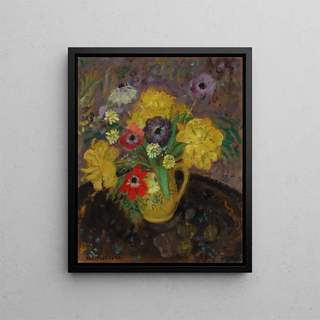Art print | The Yellow Tulips - Frederick Carl Frieseke


View from behind

Frame (optional)
In the vast and captivating universe of art, certain works manage to capture the very essence of natural beauty. "Les Tulipes jaunes" by Frederick Carl Frieseke is a perfect example. This canvas, vibrant with colors and light, evokes an atmosphere of serenity and contemplation. Through this artwork, the artist transcends the simple floral arrangement to offer an immersive sensory experience. The tulips, symbols of renewal and delicacy, bloom under Frieseke's brush, revealing a palette of dazzling yellows that illuminate the space. By immersing yourself in this art print, the viewer is invited to feel the softness of a spring garden, where each petal seems to dance with the breeze.
Style and uniqueness of the work
Frederick Carl Frieseke's style is distinguished by an impressionist approach, skillfully blending light and color. In "Les Tulipes jaunes," the artist uses fluid and dynamic brushstrokes to pay homage to the ephemeral beauty of flowers. The brightness of the tulips is accentuated by a subtle play of shadows and reflections, creating a depth that draws the eye. The shades of yellow, ranging from gold to pastel, blend harmoniously, evoking the warmth of spring sunshine. This artwork is not just a simple floral representation; it becomes a true visual poem, where each color tells a story, and each form unfolds gracefully. The composition, both balanced and bold, demonstrates Frieseke's technical mastery, while leaving room for the raw emotion that nature evokes.
The artist and his influence
Frederick Carl Frieseke, born in 1874, is an iconic figure of the American impressionist movement. His artistic journey, marked by influences from both European and American sources, allowed him to develop a unique style, imbued with light and color. After studying in Paris, Frieseke immersed himself in the artistic environment of Giverny, where he mingled with masters such as Claude Monet. This experience profoundly influenced his work, leading him to explore themes of nature and

Matte finish

View from behind

Frame (optional)
In the vast and captivating universe of art, certain works manage to capture the very essence of natural beauty. "Les Tulipes jaunes" by Frederick Carl Frieseke is a perfect example. This canvas, vibrant with colors and light, evokes an atmosphere of serenity and contemplation. Through this artwork, the artist transcends the simple floral arrangement to offer an immersive sensory experience. The tulips, symbols of renewal and delicacy, bloom under Frieseke's brush, revealing a palette of dazzling yellows that illuminate the space. By immersing yourself in this art print, the viewer is invited to feel the softness of a spring garden, where each petal seems to dance with the breeze.
Style and uniqueness of the work
Frederick Carl Frieseke's style is distinguished by an impressionist approach, skillfully blending light and color. In "Les Tulipes jaunes," the artist uses fluid and dynamic brushstrokes to pay homage to the ephemeral beauty of flowers. The brightness of the tulips is accentuated by a subtle play of shadows and reflections, creating a depth that draws the eye. The shades of yellow, ranging from gold to pastel, blend harmoniously, evoking the warmth of spring sunshine. This artwork is not just a simple floral representation; it becomes a true visual poem, where each color tells a story, and each form unfolds gracefully. The composition, both balanced and bold, demonstrates Frieseke's technical mastery, while leaving room for the raw emotion that nature evokes.
The artist and his influence
Frederick Carl Frieseke, born in 1874, is an iconic figure of the American impressionist movement. His artistic journey, marked by influences from both European and American sources, allowed him to develop a unique style, imbued with light and color. After studying in Paris, Frieseke immersed himself in the artistic environment of Giverny, where he mingled with masters such as Claude Monet. This experience profoundly influenced his work, leading him to explore themes of nature and






